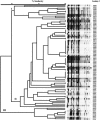Multilocus sequence typing lacks the discriminatory ability of pulsed-field gel electrophoresis for typing Salmonella enterica serovar Typhimurium
- PMID: 15872244
- PMCID: PMC1153745
- DOI: 10.1128/JCM.43.5.2215-2219.2005
Multilocus sequence typing lacks the discriminatory ability of pulsed-field gel electrophoresis for typing Salmonella enterica serovar Typhimurium
Abstract
Nontyphoidal salmonellae are among the leading causes of food-borne disease in the United States. Because of the importance of Salmonella enterica in food-borne disease, numerous typing methodologies have been developed. Among the several molecular typing methods, pulsed-field gel electrophoresis (PFGE) is currently considered the "gold standard" technique in typing Salmonella. The aim of this study was to compare the discriminatory power of PFGE to multilocus sequence typing (MLST) in typing Salmonella enterica serovar Typhimurium clinical isolates. A total of 85 Salmonella Typhimurium clinical isolates from cattle were used in this study. PFGE using XbaI was performed on the 85 isolates by the Centers for Disease Control and Prevention method, and data were analyzed using the BioNumerics software package. Fifty PFGE profiles were observed among the isolates, and these grouped into three major clusters. For the MLST analysis, the manB, pduF, glnA, and spaM genes were amplified by PCR from the same 85 isolates. DNA sequencing of these four genes, manB, pduF, glnA, and spaM, showed no genetic diversity among the isolates tested, with a 100% identity in nucleotide sequence. Moreover, the DNA sequences of the aforementioned genes showed 100% identity to the sequence reported in GenBank for the S. enterica serovar Typhimurium LT2 strain. Therefore, MLST, using these genes, lacks the discriminatory power of PFGE for typing Salmonella enterica serovar Typhimurium.
Figures

References
-
- Adiri, R. S., U. Gophna, and E. Z. Ron. 2003. Multilocus sequence typing (MLST) of Escherichia coli O78 strains. FEMS Microbiol. Lett. 222:199-203. - PubMed
-
- Bender, J. B., C. W. Hedberg, D. J. Boxrud, J. M. Besser, J. H. Wicklund, K. E. Smith, and M. T. Osterholm. 2001. Use of molecular subtyping in surveillance for Salmonella enterica serotype Typhimurium. N. Engl. J. Med. 344:189-195. - PubMed
-
- Edwards, R. A., G. J. Olsen, and S. R. Maloy. 2002. Comparative genomics of closely related salmonellae. Trends Microbiol. 10:94-99. - PubMed
Publication types
MeSH terms
Substances
LinkOut - more resources
Full Text Sources
Miscellaneous

